Quantum orbitals - Study guides, Class notes & Summaries
Looking for the best study guides, study notes and summaries about Quantum orbitals? On this page you'll find 253 study documents about Quantum orbitals.
Page 4 out of 253 results
Sort by
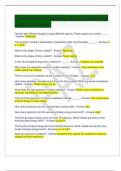
-
Quantum Numbers Test Questions with Answers
- Exam (elaborations) • 2 pages • 2024
-
Available in package deal
-
- $13.89
- + learn more
Quantum Numbers Test Questions with Answers Orbitals with different shapes occupy different regions. These regions are called _____. - Answer-Sublevels The quantum numbers designated in ascending order use the letters _____. - Answer-s, p, d, and f What is the shape of the s orbital? - Answer-Spherical What is the shape of the p orbital? - Answer-Figure eights In the nth principal energy level, orbitals of _____. - Answer-n shapes are possible What does the magnetic quantum numb...
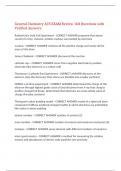
-
General Chemistry ACS EXAM Review 168 Questions with Verified Answers,100% CORRECT
- Exam (elaborations) • 14 pages • 2024
-
- $12.49
- + learn more
General Chemistry ACS EXAM Review 168 Questions with Verified Answers Rutherford's Gold Foil Experiment - CORRECT ANSWER proposed that atoms consist of a tiny, massive, positive nucleus surrounded by electrons nucleus - CORRECT ANSWER contains all the positive charge and nearly all the mass of the atom James Chadwick - CORRECT ANSWER discovered the neutron cathode rays - CORRECT ANSWER move from negative electrode to positive electrode (like electrons in a voltaic cell) Thompson...
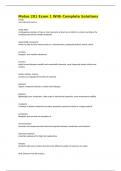
-
Matse 201 Exam 1 With Complete Solutions
- Exam (elaborations) • 11 pages • 2024
-
- $10.99
- + learn more
Matse 201 Exam 1 With Complete Solutions metals most elements exist as metal alloys a homogenous mixture of two or more elements at least one of which is a metal, and where the resulting material has metallic properties intermetallic compound similar to alloy but the mixture exists as a stoichiometric compound (distinct atomic ratios) ceramics inorganic, non-metallic substances ceramics solids formed between metallic and nonmetallic elements, most frequently oxides nitr...
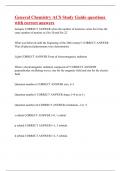
-
General Chemistry ACS Study Guide questions with correct answers
- Exam (elaborations) • 7 pages • 2023
- Available in package deal
-
- $12.49
- + learn more
Isotopes CORRECT ANSWER when the number of neutrons varies but it has the same number of protons ex) Ne-20 and Ne-22` What was believed until the beginning of the 20th century? CORRECT ANSWER That all physical phenomena were deterministic Light CORRECT ANSWER Form of electromagnetic radiation What is electromagnetic radiation composed of? CORRECT ANSWER perpendicular oscillating waves, one for the magnetic field and one for the electric field Quantum number n CORRECT ANSWER size, n&g...

-
TEST BANK FOR ORGANIC CHEMISTRY WITH BIOLOGICAL TOPICS 6th EDITION ISBN : 9781260325294 ALL CHAPTERS INCLUDED.
- Exam (elaborations) • 957 pages • 2023
-
- $25.49
- + learn more
TEST BANK FOR ORGANIC CHEMISTRY WITH BIOLOGICAL TOPICS 6th EDITION ISBN : 9781260325294 ALL CHAPTERS INCLUDED. Chapter 1 1 MULTIPLE CHOICE QUESTIONS Topic: Atomic Orbitals 1. In quantum mechanics a node (nodal surface or plane) is: A) a place where Ψ is negative. B) a place where Ψ is positive. C) a place where Ψ = 0. D) a place where Ψ 2 is large. E) a place where Ψ 2 is negative. Ans: C Topic: Atomic Orbitals, Molecular Orbitals 2. When the 1s orbitals of two hydroge...
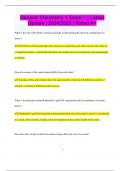
-
General Chemistry 1 Exam 1 | Latest Update | 2024/2025 | Rated A+
- Exam (elaborations) • 16 pages • 2024
- Available in package deal
-
- $9.70
- + learn more
General Chemistry 1 Exam 1 | Latest Update | 2024/2025 | Rated A+ What is the role of the Pauli exclusion principle in determining the electron configuration of atoms? The Pauli exclusion principle states that no two electrons in an atom can have the same set of quantum numbers, which helps determine the unique electron configuration and arrangement in orbitals. How do isotopes of the same element differ from each other? Isotopes of the same element have the same number of proton...
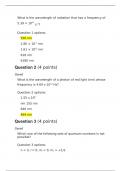
-
CHEM133 Week 6 Lesson 3 Quiz
- Exam (elaborations) • 16 pages • 2023
- Available in package deal
-
- $29.99
- + learn more
1. Question: What is the wavelength of radiation that has a frequency of 5.39 × 1014 s–1? 2. Question: What is the wavelength of a photon of red light (nm) whose frequency is 4.64 x 1014 Hz? 3. Question: Which one of the following sets of quantum numbers is not possible? 4. Question: In Bohr's atomic theory, when an electron moves from one energy level to another energy level more distant from the nucleus: 5. Question: Calculate the wavelength of a neutron that has a velocity of 250 cm/s...
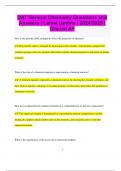
-
DAT General Chemistry Questions and Answers | Latest Update | 2024/2025 | Graded A+
- Exam (elaborations) • 30 pages • 2024
- Available in package deal
-
- $10.35
- + learn more
DAT General Chemistry Questions and Answers | Latest Update | 2024/2025 | Graded A+ How is the periodic table arranged to reflect the properties of elements? The periodic table is arranged by increasing atomic number, with elements grouped into columns (groups) and rows (periods) that reflect similar chemical properties and trends in atomic structure. What is the role of a chemical equation in representing a chemical reaction? A chemical equation represents a chemical reaction by...
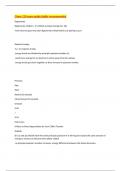
-
Chem120/ chem 120 exam-guide highly recommended
- Exam (elaborations) • 7 pages • 2024
- Available in package deal
-
- $11.29
- + learn more
Chem 120 exam guide highly recommended Degenerate Degenerate orbitals = 2+ orbitals w/equal energy (ex= 2p) -One electron goes into each degenerate orbital before any pairing occurs Requires energy 1s-> 2s requires energy -energy levels are dictated by principle quantum number (n) -need more energy for an electron to move away from the nucleus -energy levels get closer together as they increase in quantum number Orbitals B/c 2s and 2p orbitals have the same principal quant...
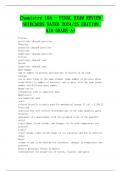
-
Chemistry 104 - FINAL EXAM REVIEW NOTECARDS RATED 2024/25 EDITION AID GRADE A+
- Exam (elaborations) • 7 pages • 2024
-
- $7.29
- + learn more
Protons positively charged particles Neutrons neutrally charged particles Electrons negatively charged particles Cations positively charged ions Anions negatively charged ions Mass Number sum of number of protons and neutrons in nucleus of an atom Isotope two or more forms of the same element (same number of protons) whose atoms differ in number of neutrons, and in mass, with the same atomic number and different mass number. Quantitative information such as numerical data Qualita...

That summary you just bought made someone very happy. Also get paid weekly? Sell your study resources on Stuvia! Discover all about earning on Stuvia


